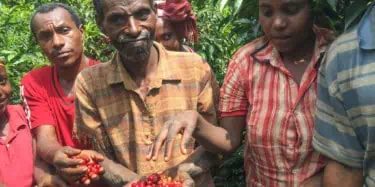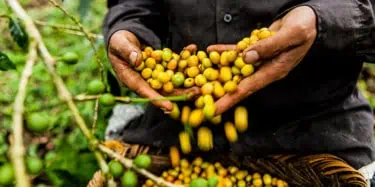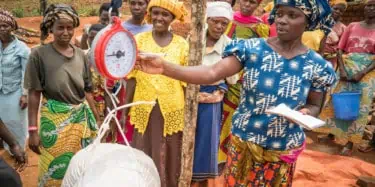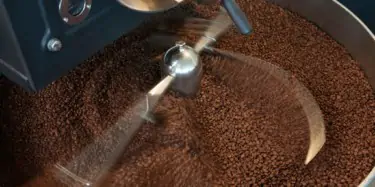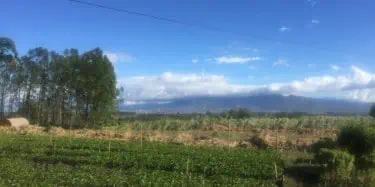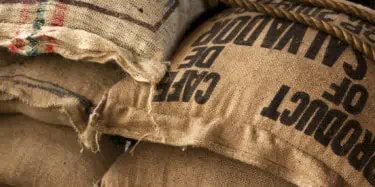Each year, we ask roasters to send us exceptional coffees available only during the holidays, coffees that might make particularly gratifying gifts or splurges for coffee-lovers. In past years, approaches have ranged from particularly fine lots of classic coffees that roasters reserved for the holiday season, to rare and often expensive seasonally available micro-lot coffees, to ingenious and
Organic-Certified Coffees from Africa: Benefits, Challenges, Complexities
Certified organic coffees must be propagated, grown, processed, transported, stored, and roasted without contact with synthetic chemicals—particularly without contact with pesticides and herbicides. The certification process (carried out by a variety of organizations operating inside a common framework) is lengthy, thorough, rather expensive, but apparently reliable and free of abuse. The use of
The New Nicaragua: Direct Trade Coffees Rule
When we first reported on coffees from Nicaragua, in 2004, the overarching theme was economic development. Specialty coffee was viewed as a way of opening access to economic and social benefits for Nicaragua’s many small- to medium-holding coffee farmers, most of whom had been decimated by the global drop in coffee prices during 1999-2003, and prior to that, by the long war that isolated the
Holding Up (More Than) Half The Sky: Coffees From Women Producers
Mao Zedong’s famous statement that “women hold up half the sky” became central to the zeitgeist of the Western feminist movement of the 1960s and ‘70s, when identity politics began to foreground the plight of women—economically, socially and politically—both in the U.S. and abroad. Regardless of one’s position on the merits of focusing on gender-based affiliations versus shared values as tools for
Exploring Roasters in the American Southwest
For Coffee Review’s monthly tasting reports we typically focus on coffee-producing countries or regions, or certain tree varieties or processing methods, or innovations that arise from the creativity of today’s specialty coffee world. It’s less often that we look at roasters, collectively, by geographical location. But this month we decided to focus on roasters of the Southwestern United States,
New Roasting Companies Carry the Third-Wave Torch
According to Global Exchange, an international human rights organization based in San Francisco, there are more than 1,200 coffee roasters in the U.S. Aside from the consumer who ultimately purchases, brews and drinks coffee, the coffee roaster is the end of the line in a complex supply chain that involves tens of millions of people, including producers in 50 coffee-growing countries; those who
Holiday Gift Coffees 2016
At the end of each year, we ask roasters for coffees they are offering consumers as special holiday selections, whether blends they have composed specifically to commemorate the holidays or single-origin coffees considered special in some way — perhaps because of limited availability, relative rarity or unusual quality. This year, we received 35 samples, ranging from small-production, quite
Q&A With Tony Greatorex of Red Rooster Coffee Roaster
How did you end up as a coffee-roaster? I worked at Starbucks for a few years, then discovered the larger world of independent specialty coffee when I moved to southwest Virginia and started working at a newly opened local shop. There, I met Haden Polseno-Hensley, the co-owner of Red Rooster Coffee Roaster, a small, young roasting company that was providing some of the beans we used. Haden
Costa Rica 2016: Innovation and Success in a Changing Market
It has been more than a decade since Coffee Review explored Costa Rica coffees in depth, though we cup many individual samples each year from this small, coffee-celebrated Central American country. In the last year alone, we reviewed 26 Costa Rica coffees at ratings of 91 to 96, including one, Temple Coffee’s Costa Rica Alberto Guardia Venecia Honey (94), which landed at the #17 spot on our 2015
Learning from Sumatras
I’ve been cupping coffee professionally for less than a year. Ken Davids first hired me at Coffee Review last August, given that my background in food and wine writing, as well as in academia, seemed a good enough calling card to dip into the world of coffee. But, of course, in order to properly do this work, I would need to be trained in cupping, the rigorous sensory evaluation of coffee. While
April Tasting Report Posts April 7
This month's tasting report looks at how six national coffee brands fare in a cupping of their online whole-bean offerings. First, we look at several small companies that have grown large and national, while still trying to preserve the special standing they established early on among consumers. Then we examine two much larger companies that grew up riding the previous “wave” of specialty coffee
Roasters: Send Us your “Macro-Lot” Samples
We review many superb “micro-lots” at Coffee Review, small lots of special, extremely refined green coffees. For next month, however, we are reviewing what we are calling “macro-lot” coffees, coffees produced from large lots of green coffee, coffees that are likely to be sold over weeks or months, and represent the sort of staple offerings that anchor a roaster’s regular business, week in and week












